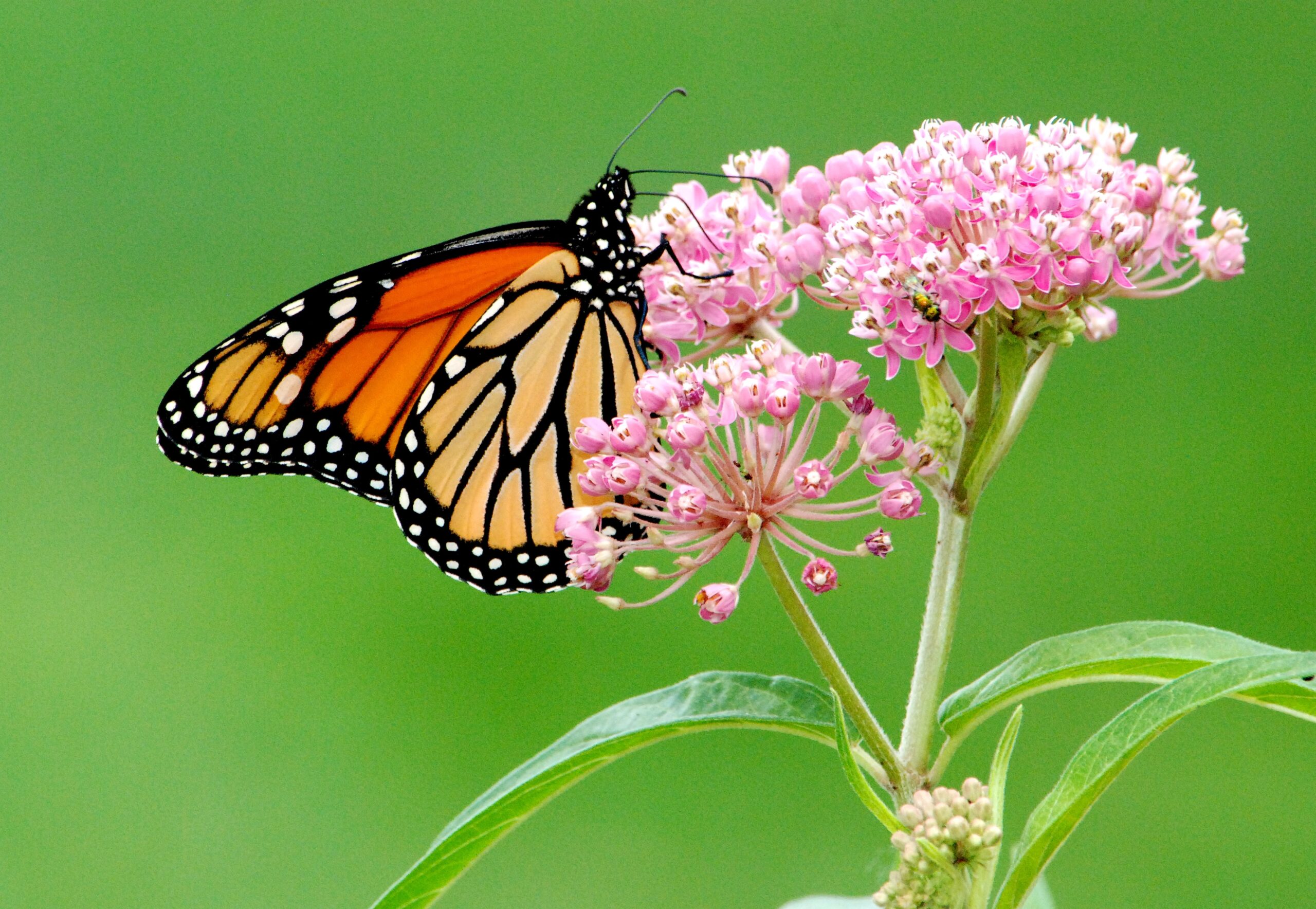International Collaborative Research by Biologists Leslie Ries and Naresh Neupane Provides Key Insights to Decline of Monarch Butterfly
Leslie Ries and Naresh Neupane, professors in the Department of Biology, contributed to research published in the journal Nature Ecology & Evolution that revealed climate change is the cause of the continued decline of the eastern monarch butterfly. The team, led by Michigan State University ecologists, was an international research partnership of professional and volunteer scientists.
“There is currently concern that insects are experiencing a general decline – often referred to in the popular press as the insect ‘apocalypse’ or ‘insectageddon’,” says Ries. “Butterflies are the best studied non-pest insect group – and the monarch butterfly in particular is a flagship species for engaging the public about insects, pollinators, and also migratory species. The cause of the monarch’s decline has also been very controversial and our recent paper is able to show that over the past 15 years, climate has been the driving force in the decline.”
A Monarch Model

Professor Leslie Ries
Changing climate at the monarch’s spring and summer breeding grounds has had the most significant impact on the dwindling population between 2004 and 2018. In fact, the effects of climate change have been nearly seven times more significant than other contributors, such as habitat loss.
In their study, Ries and her collaborators developed models to understand what is happening to biodiversity in the northwestern hemisphere by examining the decline of monarchs.
The team was particularly interested in what the data said about the three leading theories behind the eastern monarch’s population decline: milkweed habitat loss, mortality during the autumn migration and resettlement on the overwintering grounds, and climate change’s detrimental impact on monarch breeding success.
Though the findings of the study underscore the severity of the impacts of climate change, the researchers also say that it offers solutions to prevent continued deleterious effects.
“By understanding the reasons why a species is declining, there is also a message of hope: there’s something we can do about it,” says the study’s lead author Erin Zylstra, a postdoctoral researcher at Michigan State University’s integrative biology department. “We did this study not just to say what’s causing changes in the monarch butterfly population, but also to learn how we can make it better.”
A Population in Peril
Understanding the monarch’s decline and working to reverse it is important not just for preserving biodiversity, but also because insects are prolific pollinators. Since the mid-1990s, however, there has been a dramatic decline in their population, with worst-case estimates projecting that the current population is a mere 20% of what it was just a few decades ago.
The mid-1990s through the mid-2000s saw the most dramatic decline, coinciding with a period when glyphosate weed killers became hugely popular in the agricultural industry, which ultimately decimated the monarch caterpillar’s sole host and food source, the milkweed plant.
Since then, monarch populations have continued to fall. Although glyphosate-driven milkweed loss remained one possible explanation, other theories emerged over time. Today, researchers are divided on what’s stunting the monarch’s population.
About a decade ago, Ries and Elise Zipkin, senior author and an associate professor of integrative biology at MSU, realized that researchers and volunteers were collecting an increasing amount of data that could help make a more definitive determination of what’s driving the monarch population decline.
“Since there were so many different hypotheses, we tried to come in as an impartial team and take the time and put all these pieces together to really parse out the contributions of various stressors,” says Zipkin.
Mapping Monarchs

Professor Naresh Neupane
With support from the National Science Foundation, the team analyzed data from more than 18,000 surveys of monarchs in different locations across the midwestern US, central Mexico and southern Canada between 1994 and 2018. Most of these surveys were performed by local volunteers who helped count adult butterflies.
According to the researchers, the energy, expertise and dedication of the large group of international volunteers was what made the research possible.
Ries and Neupane worked on the team led by Zylstra to develop a model based on these observations and draw meaningful conclusions.
Though each of the existing hypotheses can contribute to lost butterflies at smaller scales, by looking at the problem holistically, across many years and multiple countries, the researchers were able to conclude that climate change has been the dominant disruptive force since 2004.
Every spring, monarch butterflies migrate from their overwintering grounds in the forests of central Mexico to the southern US, as they breed there and produce the next generation of monarchs. The following generation continues their journey further north and reaches southern Canada by early summer.
Neupane explains that the “count of this summer population size has been decreasing in the last three decades and the cause of this decline has until now, remained unknown, but our research has helped to solve this mystery.”
“The summer population size is driven by the weather conditions in the spring breeding grounds, which is the southern US,” Neupane continues. “Springs that are too hot in the southern US will result in smaller counts of monarchs in the summer breeding grounds in southern Canada. Furthermore, as depicted by the global climate models, if global warming continues, the southern US will be unsuitable for the growth and development of monarch butterflies.”
Due in large part to the herculean effort of collecting and making sense of this data, these research findings have made two notable contributions to the field.
First, by proving the model’s potential to tease out population dynamics for something as complicated as the eastern monarch, the team is optimistic it can adapt the model to understand what’s driving population changes in other species. Secondly, this understanding should help inform where conservation efforts can provide the greatest benefit for the eastern monarch’s numbers and where money can be allocated most effectively for restoration efforts.
Although curbing climate change is a huge lift, this study emphasizes the importance of partnerships to confront large challenges.
Ries will be giving a talk on Milkweed, Monarchs and Climate Change at the Howard County Conservancy on September 18th.
